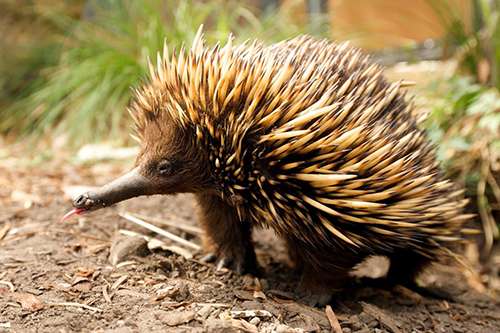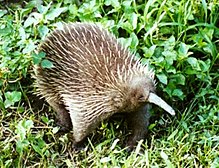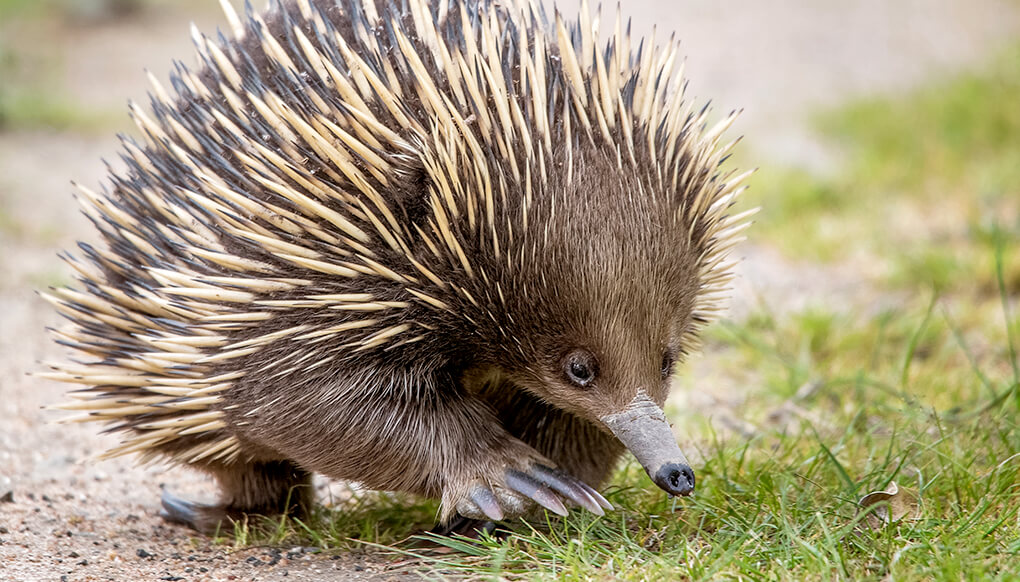Echidnas evolved between 20 and 50 million years ago, descending from a platypus-like monotreme.[3] This ancestor was aquatic, but echidnas adapted to life on land.[3]

Etymology
The echidnas are named after Echidna, a creature from Greek mythology who was half-woman, half-snake, as the animal was perceived to have qualities of both mammals and reptiles.[4]Description
Echidnas are medium-sized, solitary mammals covered with coarse hair and spines.[5]
Spines and fur of an echidna
Diet
The short-beaked echidna's diet consists largely of ants and termites, while the Zaglossus (long-beaked) species typically eat worms and insect larvae.[7] The tongues of long-beaked echidnas have sharp, tiny spines that help them capture their prey.[7] They have no teeth, and break down their food by grinding it between the bottoms of their mouths and their tongues.[8] Echidnas' faeces are 7 cm (3 in) long and are cylindrical in shape; they are usually broken and unrounded, and composed largely of dirt and ant-hill material.[8]Habitat
A short-beaked echidna building a defensive burrow in French Island National Park (43 seconds)
Despite their appearance, echidnas are capable swimmers. When swimming, they expose their snout and some of their spines, and are known to journey to water in order to groom and bathe themselves.[9]
Anatomy
Echidnas and the platypus are the only egg-laying mammals, known as monotremes. The average lifespan of an echidna in the wild is estimated around 14–16 years. When fully grown, a female can weigh up to 4.5 kilograms (9.9 lb) and a male can weigh up to 6 kilograms (13 lb).[8] The echidnas' sex can be inferred from their size, as males are 25% larger than females on average. The reproductive organs also differ, but both sexes have a single opening called a cloaca, which they use to urinate, release their faeces and to mate.[5]Male echidnas have non-venomous spurs on the hind feet.[10]
The neocortex makes up half of the echidna's brain,[11] compared to 80% of a human brain.[12][13] Due to their low metabolism and accompanying stress resistance, echidnas are long-lived for their size; the longest recorded lifespan for a captive echidna is 50 years, with anecdotal accounts of wild individuals reaching 45 years.[14] Contrary to previous research, the echidna does enter REM sleep, but only when the ambient temperature is around 25 °C (77 °F). At temperatures of 15 °C (59 °F) and 28 °C (82 °F), REM sleep is suppressed.[15]
Reproduction
The female lays a single soft-shelled, leathery egg 22 days after mating, and deposits it directly into her pouch. An egg weighs 1.5 to 2 grams (0.05 to 0.07 oz)[16] and is about 1.4 centimetres (0.55 in) long. While hatching, the baby echidna opens the leather shell with a reptile-like egg tooth.[17] Hatching takes place after 10 days of gestation; the young echidna, called a puggle,[18][19] born larval and fetus-like, then sucks milk from the pores of the two milk patches (monotremes have no nipples) and remains in the pouch for 45 to 55 days,[20] at which time it starts to develop spines. The mother digs a nursery burrow and deposits the young, returning every five days to suckle it until it is weaned at seven months. Puggles will stay within their mother's den for up to a year before leaving.[8]Male echidnas have a four-headed penis.[21] During mating, the heads on one side "shut down" and do not grow in size; the other two are used to release semen into the female's two-branched reproductive tract. Each time it copulates, it alternates heads in sets of two.[22][23] When not in use, the penis is retracted inside a preputial sac in the cloaca. The male echidna's penis is 7 centimetres (2.8 in) long when erect, and its shaft is covered with penile spines.[24] These may be used to induce ovulation in the female.[25]
It is a challenge to study the echidna in its natural habitat and they show no interest in mating while in captivity. Therefore, no one has ever seen an echidna ejaculate. There have been previous attempts, trying to force the echidna to ejaculate through the use of electrically stimulated ejaculation in order to obtain semen samples but has only resulted in the penis swelling.[23]
Breeding season begins in late June and extends through September. Males will form lines up to ten individuals long, the youngest echidna trailing last, that follow the female and attempt to mate. During a mating season an echidna may switch between lines. This is known as the "train" system.[8]
Threats
Echidnas are very timid animals. When they feel endangered they attempt to bury themselves or if exposed they will curl into a ball similar to that of a hedgehog, both methods using their spines to shield them. Strong front arms allow echidnas to continue to dig themselves in whilst holding fast against a predator attempting to remove them from the hole. Although they have a way to protect themselves, the echidnas still face many dangers. Some predators include feral cats, foxes, domestic dogs and goannas. Snakes pose a large threat to the echidna species because they slither into their burrows and prey on the young spineless puggles. Some precautions that can be taken include keeping the environment clean by picking up litter and causing less pollution, planting vegetation for echidnas to use as shelter, supervising pets, reporting hurt echidnas or just leaving them undisturbed. Merely grabbing them may cause stress, and picking them up improperly may even result in injury.[8]Evolution
The first divergence between oviparous (egg-laying) and viviparous (offspring develop internally) mammals is believed to have occurred during the Triassic period.[26] However, there is still some disagreement on this estimated time of divergence. Though most findings from genetics studies (especially those concerning nuclear genes) are in agreement with the paleontological findings, some results from other techniques and sources, like mitochondrial DNA, are in slight disagreement with findings from fossils.[27]
Molecular clock data suggest echidnas split from platypuses between 19 and 48 million years ago, and that platypus-like fossils dating back to over 112.5 million years ago therefore represent basal forms, rather than close relatives of the modern platypus.[3] This would imply that echidnas evolved from water-foraging ancestors that returned to living completely on the land, even though this put them in competition with marsupials. Further evidence of possible water-foraging ancestors can be found in some of the echidna's phenotypic traits as well. These traits include hydrodynamic streamlining, dorsally projecting hind limbs acting as rudders, and locomotion founded on hypertrophied humeral long-axis rotation, which provides a very efficient swimming stroke.[3] Consequently, oviparous reproduction in monotremes may have given them an advantage over marsupials, a view consistent with present ecological partitioning between the two groups.[3] This advantage could as well be in part responsible for the observed associated adaptive radiation of echidnas and expansion of the niche space, which together contradict the fairly common assumption of halted morphological and molecular evolution that continues to be associated with monotremes. Furthermore, studies of mitochondrial DNA in platypuses have also found that monotremes and marsupials are most likely sister taxa. It also implies that any shared derived morphological traits between marsupials and placental mammals either occurred independently from one another or were lost in the lineage to monotremes.[28]
Taxonomy
Echidnas are classified into three genera.[29] The genus Zaglossus includes three extant species and two species known only from fossils, while only one extant species from the genus Tachyglossus is known. The third genus, Megalibgwilia, is known only from fossils.Zaglossus
The Western long-beaked echidna, which is endemic to New Guinea.
- Western long-beaked echidna (Z. bruijni), of the highland forests;
- Sir David's long-beaked echidna (Z. attenboroughi), discovered by western science in 1961 (described in 1998) and preferring a still higher habitat;
- Eastern long-beaked echidna (Z. bartoni), of which four distinct subspecies have been identified.
Tachyglossus
In Australia, the short-beaked echidna may be found in many environments, including urban parkland, such as the shores of Lake Burley Griffin in Canberra, as depicted here.
A short-beaked echidna curled into a ball; the snout is visible on the right
Megalibgwilia
The genus Megalibgwilia is known only from fossils:- M. ramsayi from Late Pleistocene sites in Australia;
- M. robusta from Miocene sites in Australia.







No comments:
Post a Comment
Note: Only a member of this blog may post a comment.